Turbine Electricity
-
- Shipbuilding: DDW's Future is Bright Maritime Reporter, Mar 2013 #42
During the past two years Drydocks World (DDW) has suffered from the restraints of a financial problem following the purchase of one shipyard in Singapore and one on the Indonesian island of Batam (both former Pan United shipyards) and two more on Batam (both former Leroy shipyards).
This debt has now been restructured and the management of those yards has been taken over by China’s Paxocean, thus leaving DDW is a much better state and looking forward to a better future.
The main yard of DDW is Drydocks World – Dubai (DDW-D), which competes in the shiprepair, conversion and newbuilding industries and, despite the introduction of two additional shipyards in the Middle East, remains the largest and most successful of the Middle East facilities.
During 2013 there will be some changes to the look of DDW-D’s yard. It is intended that the newbuilding area will be extended with a specially-designed newbuilding quay alongside the yard, where currently the floating dock is located. The floating dock will be moved to a site in Dubai Maritime City (DMC) and operate alongside another floating dock, which was formerly the Platinum Yachts floating dock located in Jebel Ali. At the end of the newbuilding quay there will be a number of lay-by berths available for jack-up rigs.
On the conversion side of DDW-D’s activities, there are currently two major projects coming to fruition. The first is the FLNG Toscana, formerly the LNG tanker Golar Frost, which is now completed as far as the shipyard is concerned. She is currently undergoing owner’s commissioning tests prior leaving the Middle East for Italy and installation at a terminal offshore Livorno, Italy. The unit will be owned by OLT Offshore and operated by Saipem. She will eventually leave Dubai during the first quarter of 2013.
This is one of the most sophisticated conversion projects carried out by the shipyard. The scope of work for the shipyard included:
• Detailed Engineering: – complete turret construction methodology worked out by the Yard’s engineers so there was no damage to the Inconel cladding of the turret bearings. In addition the 2,000 tonnes re-gasification module T-16 was an engineering challenge to lift and install on-board.
• Procurement: – with restrictions to sourcing the material required for the various grades of piping, mainly Cunifer and Cryo and the stringent MED and 3.2 certification requirements - an on-going challenge.
• Construction: - the project included routine complex work as part of the scope related to topsides such as the fabrication and installation of the 600 tonnes, 25 m high external turret and turret mooring system, installation of the four prototype loading arms weighing 75 tonnes each, and lifting, installing and tie-ins for the 2,100 tonnes re-gasification T-16 and the 400 tonnes T-20 wobbe index modules, installation and tie-ins for the two 10,000 kW STGs and installation of the unique articulated-type vent tower are other significant firsts. In all 97,272 inch-diameter of piping, including exotic material for cryogenic piping and over 320 kms of cable pulling was completed for the project. Extensive piping fabrication work including stainless steel piping for the handling of LNG cargo at -163 degreeC, and insulating with PUF type material was carried out. Major vessel and topside work carried out included chain table replacement for the turret mooring system, side-by-side berthing mooring system installation, modification of cargo pump tower internal structure and installation of retractable cargo pumps, installation of the pipe rack module, product sea water systems piping with diameters up to 132 cm. Total steel tonnage fabricated and installed for vessel conversion was 4,400 tonnes and was compliant with the highest quality standards in the maritime industry.
• Pre-commissioning and assistance to final commissioning: - Final commissioning of the newly-installed HVAC system was completed by the yard and sub-contractors. In addition the yard has provided support to the client for other commissioning work such as the cool-down of cryogenic piping, boiler flash-up, performance trial run of power generators, harbour acceptance test of aft thruster and leak test of the natural gas piping.
All of this work was completed consuming 9.57 million man hours with only three LTIs. It is expected that a total of 9.59 million man hours will be consumed by the time of project completion.
The second project involves two 120,000 dwt tankers, the Eagle Texas and the Eagle Louisiana, owned by Singapore’s AET Shipmanagement and being converted by DDW-D to become Modular Capture Vessels (MCVs) for use in emergency oil spills in the Gulf of Mexico.
Both vessels were newbuildings from Japan’s Tsuneishi Shipyard. Following the Deepwater Horizon disaster, it was decided by Marine Well Containment Co (MWCC), which is a collaboration of some 10 oil majors, that this concept would be available in times of such emergencies. The MCV would be able, in cases such as the Deepwater Horizon, to capture the oil from the seabed area thus preventing the kind of environmental disaster seen two years ago.
Some of the modules for this concept will be placed on-board in Dubai with more awaiting the ships’ arrival in the Gulf of Mexico. Both tankers will operate as normal lightening vessels in the Gulf of Mexico with the modules being made available to load on-board immediately when an oil spill disaster is apparent. These are the first ships to be used in this type of concept, and DDW-D are expecting that more will follow, not just for the Gulf of Mexico, but for others areas worldwide. DDW-D has carried out some 27 conversion projects over recent years including all such projects for Italy’s Saipem and Norway’s Fred Olsen.
DDW has also been involved in the initial stages of the refit of the famous Cunard liner Queen Elizabeth 2 (QE2). It has been tied up in Port Rashid, Dubai for the past number of years (since November 2008) while her fate has been decided. She is now in DDW-D for undertaking classification checks prior to her renovation as a luxury floating hotel. No shipyard has yet been named to carry out the renovation work.
She was built by John Brown & Co. (Clydebank) and delivered in 1969 as a 70,327 tons passenger liner for the transatlantic trade, before becoming a worldwide cruise vessel. She carried 2.5m passengers, sailed nearly 6m miles and completed 806 trans-Atlantic crossings during 39 years of service for Cunard. She also saw active service as a troop carrier during the 1982 Falklands War. She was originally built at a steam-powered vessel, changing to diesel-electric power (using nine MAN diesels) during 1986/7 at Germany’s Lloyd Werft, Bremerhaven. A service speed of 32 knots was achieved after the re-engining operation, which cost some £100m.
QE2 Dubai has created a large consortium to convert the QE2 into a five-star hotel with 500 rooms managed by a prestigious international hotel as an operator. The Oceanic Group, a group of deeply-experienced advisers to cruise operators and managers in Asia, will take the lead in managing this project while DDW-D will carry out extensive technical and operational checks prior to her move into Asia..
The vision for the QE2 is for her to become a landmark cultural and tourist attraction-a beacon of luxury, glamour, quality and tradition - in the heart of a leading Asian city that shares her rich maritime heritage and is prepared to give this very special ship the prominent waterfront home she so richly deserves. The consortium will lavish many millions of dollars on this magnificent ship to restore her to the splendour of her glory days as an icon of the very best the world has to offer.
A number of Asian cities have expressed interest in securing this historic attraction. An international tourist city in the Far East is to be her first destination. Plans for the upgrading of the QE2 also include a shopping mall with the finest world leading brands, a QE2 Café offering meals similar to those served during cruises, three Michelin-starred restaurants, convention and meeting facilities. There will also be an on-board maritime museum displaying QE2 memorabilia and her rich history, along with a collection of treasures of Dubai.
On the newbuilding side of DDW-D’s activities, there are three projects currently underway. The yard is building the Prelude FLNG turret for installation into a FLNG currently being constructed by South Korea’s Samsung Heavy Industries (SHI). This is a joint venture between Shell, SBM (Offshore) and Technip, and will be the first such project ever carried out. The turret will be delivered to South Korea in three phases starting in July 2014.
The second newbuilding is Aibel’s semi-submersible High Voltage Direct Current (HVDC) platform building Dolwin Beta for ABB to be used to convert turbine electricity to direct current in the North Sea wind farm industry. The unit is due for delivery in early 2014.
The third newbuilding project is a 400,000 bbls sub-sea storage tank for Premier Oil (UK). The structure will be located on the Solan Field in the UK sector of the North Sea and operated by Chrysaor.(As published in the March 2013 edition of Maritime Reporter & Engineering News - www.marinelink.com)
-
 )
March 2024 - Marine Technology Reporter page: 25
)
March 2024 - Marine Technology Reporter page: 25many mountains, hills, valleys and canyons that APPLICATIONS would rival anything seen on land.” • Shallow Gas Hazard Surveys • Oi shore Wind Turbine Phase two, mapping inside the caldera, • Geotechnical InvesO gaO on • Sand Resource InvesO gaO on featured SEA-KIT International’s USV
-
 )
April 2024 - Maritime Reporter and Engineering News page: 35
)
April 2024 - Maritime Reporter and Engineering News page: 35. est ship-handling simulators to reproduce the movement of MarinePALS founder Captain Pradeep Chawla says that a vessel pushing against an offshore wind turbine in severe people are used to accessing information in a variety of short weather and sea conditions, aiming to improve the advanced and entertaining
-
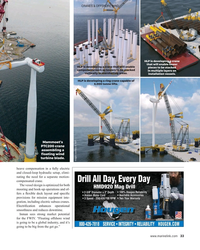 )
April 2024 - Maritime Reporter and Engineering News page: 33
)
April 2024 - Maritime Reporter and Engineering News page: 33areas. installation vessels. HLP is developing a ring crane capable of 6,000 tonne lifts. Mammoet’s PTC200 crane assembling a ? oating wind turbine blade. Images courtesy of HLP heave compensation in a fully electric and closed-loop hydraulic setup, elimi- nating the need for a separate motion- comp
-
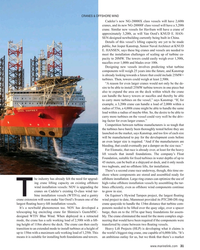 )
April 2024 - Maritime Reporter and Engineering News page: 31
)
April 2024 - Maritime Reporter and Engineering News page: 31Kanstrup, Senior Naval Architect at KNUD E. HANSEN, says these big cranes and vessels are needed to meet the installation challenges of scaling up of turbine ca- pacity to 20MW. The towers could easily weigh over 1,500t, nacelles over 1,000t and blades over 100t. Designing new vessels involves predicting
-
 )
April 2024 - Maritime Reporter and Engineering News page: 25
)
April 2024 - Maritime Reporter and Engineering News page: 25or older and need to be that are government owned and operated ships, government replaced. We’re talking all the way from steam to diesel and some gas turbines. The commercial world doesn’t use owned and contract operated, and contract owned and con- steam any more, but we still have quite a few steam-pow- tract
-
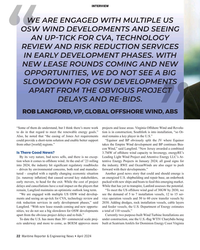 )
April 2024 - Maritime Reporter and Engineering News page: 22
)
April 2024 - Maritime Reporter and Engineering News page: 22not see a big slowdown for OSW developments a total of 110 vessels.” apart from the obvious project delays and re-bids.” Currently two purpose-built Wind Turbine Installations are To date the U.S. has more than 30+ commercial scale proj- under construction, one the U.S.-? ag WTIV Charybdis being ects underway
-
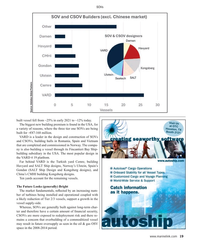 )
April 2024 - Maritime Reporter and Engineering News page: 19
)
April 2024 - Maritime Reporter and Engineering News page: 19designs. Ten yards account for the remaining vessels. The Future Looks (generally) Bright The market fundamentals, re? ected by an increasing num- ber of turbines being installed and operational coupled with a likely reduction of Tier 2/3 vessels, support a growth in the vessel supply-side. Whereas, SOVs
-
 )
April 2024 - Maritime Reporter and Engineering News page: 17
)
April 2024 - Maritime Reporter and Engineering News page: 17SOVs China, we do not look at demand for SOVs/CSOVs as having a linear rela- tionship to the number of wind farms or turbines installed. We look to see where a large number of wind turbines are concentrated in relatively close proximity, generally in a very large wind farm or in a project cluster
-
 )
April 2024 - Maritime Reporter and Engineering News page: 16
)
April 2024 - Maritime Reporter and Engineering News page: 16relatively limited. SOV: Service operations vessels, generally on long- ¦Tier 1: purpose-built vessels for offshore wind with term charter to a wind turbine OEM or offshore wind in-built crane and gangway. farm operator to service and maintain equipment dur- ¦Tier 2: Generally, oil & gas tonnage (MPSVs
-
 )
April 2024 - Maritime Reporter and Engineering News page: 13
)
April 2024 - Maritime Reporter and Engineering News page: 13from gasoline to methanol, but compared to just buying an EV After some pondering, I think I can reduce it to this logi- today that is a pointless exercise. It would actually make more cal sequence: sense to buy a plug-in hybrid that is con? gured for methanol It is the carbon. We want zero carbon as
-
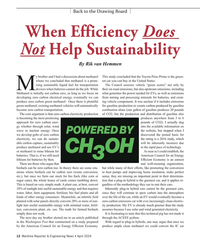 )
April 2024 - Maritime Reporter and Engineering News page: 12
)
April 2024 - Maritime Reporter and Engineering News page: 12Back to the Drawing Board When Efficiency Does Not Help Sustainability By Rik van Hemmen y brother and I had a discussion about methanol This study concluded that the Toyota Prius Prime is the green- where we concluded that methanol is a prom- est car you can buy in the United States. ising sustainable
-
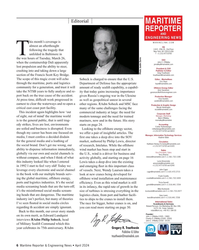 )
April 2024 - Maritime Reporter and Engineering News page: 6
)
April 2024 - Maritime Reporter and Engineering News page: 6heads that are the turn-off; in its infancy, the rapid rate of growth in the Mike Kozlowski it’s the misinformed social media scream- size of turbines is stressing everything in the [email protected] | +1.561.733.2477 ing heads that are dangerous. The maritime logistics chain, from port
-
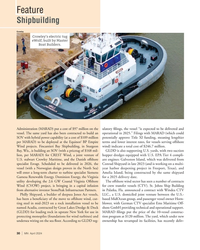 )
April 2024 - Marine News page: 30
)
April 2024 - Marine News page: 30multi- vessel (with a Norwegian design proven in the North Sea) year harbor deepening project in Freeport, Texas), and will enter a long-term charter to turbine specialist Siemens Amelia Island, being constructed by the same shipyard Gamesa Renewable Energy. Dominion Energy, the Virginia for a 2025 delivery
-
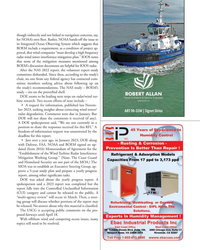 )
April 2024 - Marine News page: 25
)
April 2024 - Marine News page: 25, in January 2023, DOE along with Defense, FAA, NOAA and BOEM signed an up- dated (from 2016) Memorandum of Agreement for the “Establishment of the Wind Turbine Radar Interference Mitigation Working Group.” (Note: The Coast Guard and Homeland Security are not part of the MOA.) The MOA was to establish an
-
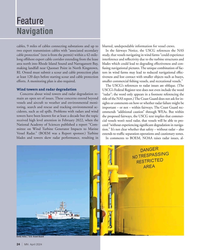 )
April 2024 - Marine News page: 24
)
April 2024 - Marine News page: 24navigating in wind farms “could experience long offshore export cable corridor extending from the lease interference and re? ectivity due to the turbine structures and area north into Rhode Island Sound and Narragansett Bay, blades which could lead to degrading effectiveness and con- making landfall
-
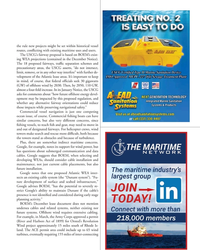 )
April 2024 - Marine News page: 23
)
April 2024 - Marine News page: 23Act of 1899) for Orsted’s Revolution Wind project approximately 15 miles south of Rhode Is- land. The ACE permit area could include up to 65 wind turbines, eventually requiring 155 miles of inter-connecting
-
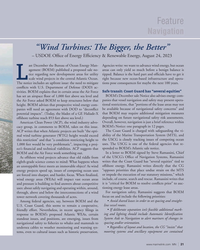 )
April 2024 - Marine News page: 21
)
April 2024 - Marine News page: 21Feature Navigation “Wind Turbines: The Bigger, the Better” – USDOE Of? ce of Energy Ef? ciency & Renewable Energy, August 24, 2023 ast December the Bureau of Ocean Energy Man- Agencies write: we want to advance wind energy, but ocean agement (BOEM) published a proposed sale no- areas can only yield so
-
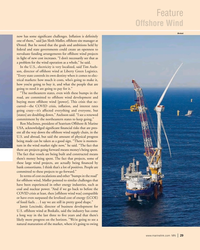 )
February 2024 - Marine News page: 29
)
February 2024 - Marine News page: 29Feature Offshore Wind Ørsted now has some signi? cant challenges. In? ation is de? nitely one of them,” said Jan Sloth Møller, offshore site manager at Ørsted. But he noted that the goals and ambitions held by federal and state governments could create an openness to reevaluate funding arrangements for
-
 )
January 2024 - Marine Technology Reporter page: 56
)
January 2024 - Marine Technology Reporter page: 56FLOATING OFFSHORE WIND GAZELLE WIND POWER We’re already working on the pre-FEED, and now we’re go- clude 70 turbines of 15MW each, and has preselected Gazelle ing to be working on the engineering portion. Our main goal as one of the providers for the offshore wind platform. So, is to prove the concept
-
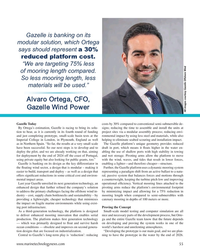 )
January 2024 - Marine Technology Reporter page: 55
)
January 2024 - Marine Technology Reporter page: 55in some critical cost and environ- ral, passive system that balances forces and motions through mental impact areas. a counterweight, keeping the turbine pitch low and improving Last year Gazelle unveiled its next generation technology, an operational ef? ciency. Vertical mooring lines attached to
-
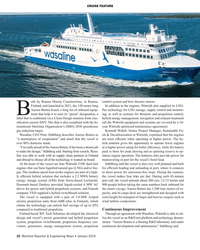 )
January 2024 - Maritime Reporter and Engineering News page: 32
)
January 2024 - Maritime Reporter and Engineering News page: 32pair of 5.8-MW Azipod extra height for transport of larger and heavier cargoes such as electric propulsion units from ABB (also in Finland), which wind turbine components. claims the technology can unlock fuel savings of up to 20% Continuous Improvement compared to traditional propulsion. Finland-based WE
-
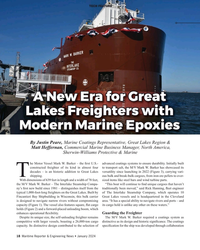 )
January 2024 - Maritime Reporter and Engineering News page: 18
)
January 2024 - Maritime Reporter and Engineering News page: 18and break-bulk cargoes, from iron ore pellets to over- With dimensions of 639 feet in length and a width of 78 feet, sized items like steel bars and wind turbine parts. the M/V Mark W. Barker – The Interlake Steamship Compa- “This boat will continue to ? nd unique cargoes that haven’t ny’s ? rst new build
-
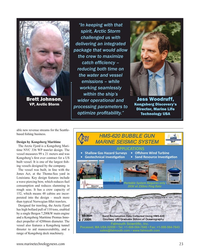 )
November 2023 - Marine Technology Reporter page: 23
)
November 2023 - Marine Technology Reporter page: 23SEISMIC SYSTEM The Arctic Fjord is a Kongsberg Mari- APPLICATIONS time NVC 336 WP trawler design. The • Shallow Gas Hazard Surveys • Oi shore Wind Turbine vessel measures 99 x 21 meters and was • Geotechnical InvesO gaO on • Sand Resource InvesO gaO on Kongsberg’s ? rst ever contract for
-
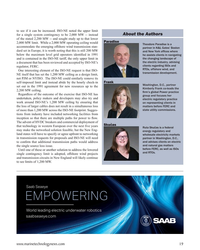 )
November 2023 - Marine Technology Reporter page: 19
)
November 2023 - Marine Technology Reporter page: 19to see if it can be increased. ISO-NE noted the upper limit About the Authors for a single system contingency to be 2,000 MW -- instead of the stated 2,200 MW -- and sought study up to that lower Paradise 2,000 MW limit. While a 2,000 MW operating ceiling would Theodore Paradise is a accommodate the
